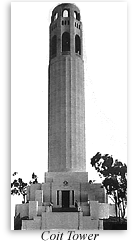|
Elizabeth Wyche
“Lillie” Hitchcock Coit
By Frederick J. Bowlen
Battalion Chief, San Francisco Fire Department
One of the most unusual personalities ever connected with
our Fire Department was a woman. She was Lillie Hitchcock Coit, who was
destined not only to become a legend but to attain that eminence long before
her life ended.
She came to this city in 1851 from West Point, where her father had
been an army doctor. Seven years later, when only 15 years old, she began
her famous career with Knickerbocker Engine Company No. 5.
One afternoon that pioneer fire company had a short staff on the ropes
as it raced to a fire on Telegraph Hill. Because of the shortage of man
power, the engine was falling behind. Oh, humiliating and better was the
repartee passed by Manhattan No. 2 and Howard No. 3 as the total eclipse
seemed to be but a matter of seconds. Then, suddenly there came a diversion.
It was the story of Jeanne d’Arc at Orleans, The Maid of Sargossa and Molly
Pitcher of Revolutionary fame all over again.
Pretty and impulsive Lillie Hitchcock, on her way home from school,
saw the plight of the Knickerbocker and tossing her books to the ground,
ran to a vacant place on the rope. There she exerted her feeble strength
and began to pull, at the same time turning her flushed face to the bystanders
and crying: “Come on, you men! Everybody pull and we’ll beat ‘em!”
A Famous Day for Little Lillie
Everybody did come and pull and Knickerbocker No. 5 went up the slope
like a red streak, and got first water on the fire.
That was a famous day for Lillie. From that time on she caught the spirit
of the Volunteers and Dr. Hitchcock had difficult work attempting to keep
his daughter from dashing away every time an alarm was sounded. As it was,
there never was a gala parade in which Lillie was not seen atop Knickerbocker
No. 5, embowered in flags and flowers. She was, literally, the patroness
of all the firemen of her city.
From her earliest infancy she was curiously fascinated by the red shirt
and war-like helmet of the firemen and she gloried in the excitement of
a big blaze. Almost invariably, with the energy and speed that the most
agile fireman might envy, she hastened to the scene of action. Lillie often
said she loved courage in a uniform.
San Francisco society of the day was exclusive and right. As the Hitchcocks
were valued members, society frequently agonized over the vagaries of its
Lillie. But she seems always to have done exactly as she pleased without
giving real offense.
On October 3, 1863, she was elected an honorary member of the Knickerbocker
company, and always regarded that honor as the proudest of her life. She
wore the numeral as an ornament with all her costumes, along with the gold
badge presented at the same time.
As Miss Hitchcock became older, she gave up the habit of following
the engine, but the tie that bound her to the company was as strong as
ever. If any member of a company fell ill, it was Lillie Hitchcock who gladdened
the sickroom. And should death call him, she sent a floral tribute as final
expression of her regard.
A Steadfast Love for California
After her marriage to Howard Coit, a caller at the San Francisco Stock
and Bond Exchange, she traveled extensively in the East, in Europe and
the Orient. Notwithstanding all her wanderings, her love for California
was steadfast and she at length made it her permanent home.
She was a notable figure even at the court of Napoleon III and a maharaja
of India, and later, when she came back to San Francisco to live she brought
with her a remarkable collection of gifts from royalty and others. They
included gems of rare value, objects of art, mementos and souvenirs, some
of them priceless.
When Mrs. Coit died here in July 22, 1929, at the age of 86, she gave
practical evidence of her affection for San Francisco. She left
one-third
of her fortune to the city “to be expended in an appropriate manner
for the purpose of adding to the beauty of the city which I have always
loved.”
 For several years after her death, there was question as to the most
fitting interpretation of the “appropriate manner” in which to
make the memorial. The executors of her will at last determined to erect
a memorial tower in honor of this colorful woman and also a memorial tribute
to San Francisco’s firemen. For several years after her death, there was question as to the most
fitting interpretation of the “appropriate manner” in which to
make the memorial. The executors of her will at last determined to erect
a memorial tower in honor of this colorful woman and also a memorial tribute
to San Francisco’s firemen.
Both have been completed for some time. The novel appearance of the
180-foot cylindrical tower which stands atop Telegraph Hill is surely significant
symbol to the memory of one whose individuality made her as outstanding
an example of the contrast to her days as is this unusual form of memorial
shaft.
The second memorial to her was unveiled in Washington Square, December
3, 1933. It is a sculptured block representing a
life-sized group of three
firemen, one of them carrying a woman in his arms.
San Francisco Chronicle
May 30, 1939 Return to the top of the page. |